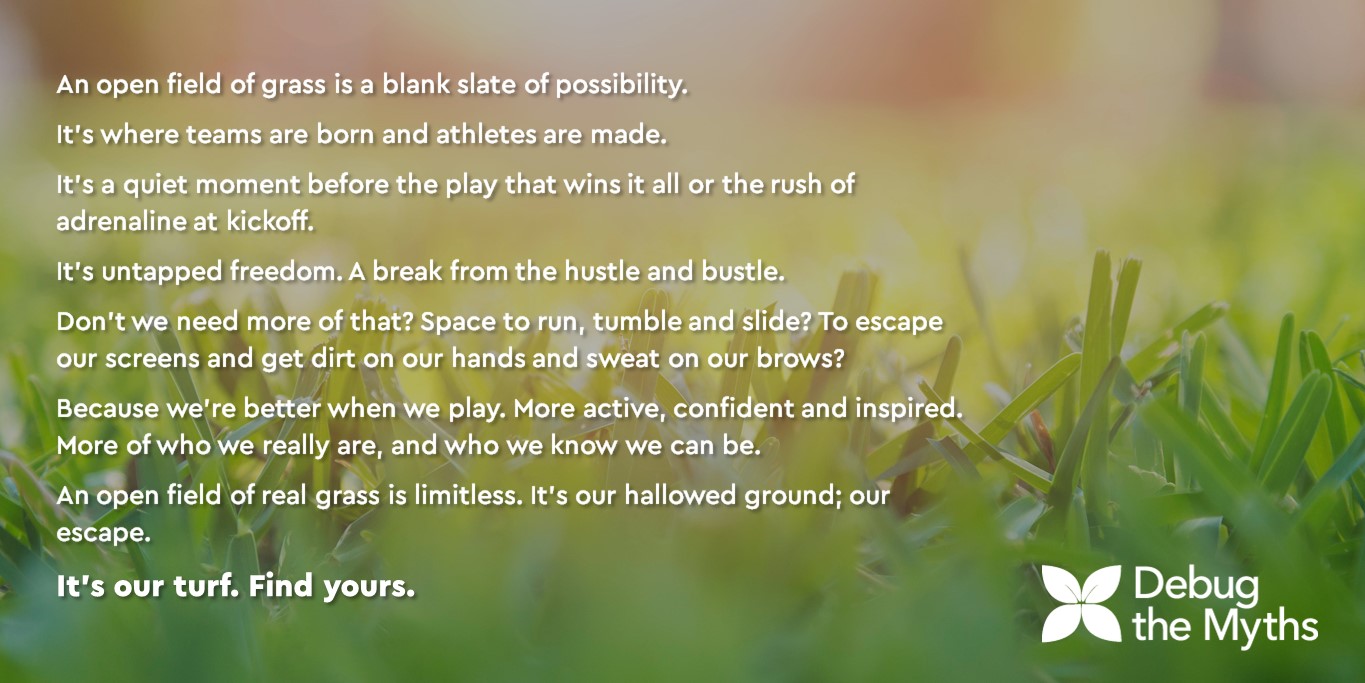My Turf

#MyTurf is a mindset. It’s choosing real grass, spending time outside and going the extra mile to create and maintain spaces where everyone can play. It’s more than a healthy, lush and green field. It’s the ideal playing surface where the soccer ball flies through the field for 90 minutes. It’s a place to throw the Frisbee with real grass beneath your feet.
We need to take care of these spaces and keep them playable through an integrated approach. Well-maintained outdoor spaces make a difference. They increase curb appeal and can bolster homeowners’ property values. They inspire kids’ imaginations and support healthy play. They keep athletes safe from unforeseen obstacles during games.
Sharing information about the importance and how to care for outdoor spaces is our turf. Explore more to find yours.
Find a Park
Looking for real grass spaces to enjoy? Find a park in your city and get outside!
The #MyTurf movement urges everyone from professional athletes to homeowners to share what real grass means to them and bring attention to the value outdoor, grassy areas provide to people of all ages. Join the movement and tell us what real grass means to you by tagging @DebugtheMyths on Twitter and using #MyTurf.
Learn more about real grass playing surfaces across the country, and how they enhance the communities they serve and benefit the athletes that run and tumble on their grass.
Your yard and the green spaces around your home are an invaluable extension of playtime, exploration and memory making. Access to well-maintained, real grass either in your backyard, or close by at the neighborhood park, mean more than curb appeal; they create a homegrown neighborhood hangout, a soft surface for pickup soccer and claimed territory for your furry family members.
Here’s why you should have real grass at home and down the street:
- Healthy kids need play time; and, therefore, outdoor places to play. The USDA recommends kids and teens be active for at least one hour every day, yet 30 million children in these age groups fail to meet this requirement. The results prove that playing outdoors does make a difference for growing children and their health. Research shows physically active children have up to 40 percent higher test scores. And, they are more likely to grow into adaptable adults. A recent Power of Play study by the American Academy of Pediatrics found that allowing kids to play in groups, especially at a young age, enables children to discover their own interests and develop decision-making and problem-solving skills.
- Green spaces boost property value. Real grass lawns, fields and spaces invite families to step outside and enjoy the outdoors. Lush grass yards make a first impression for home buyers and often a differentiating factor from other homes. Desirable public parks or other recreational open spaces boost property value of nearby homes by 8-20 percent.
- The cooler option for kids and pets. Whether you’re playing backyard fetch, or headed to the park, real grass is an always-cool surface for your kids and furry family members to run and play. This is especially important when temperatures rise above 85 degrees.
The importance of available, well-maintained, natural playing surfaces is an ongoing discussion within the athletic community. The debate came to the forefront before and during the 2015 Women’s World Cup, as all games were played on artificial turf. The conversation continues among athletes within the NFL community, fighting to bring back grass fields. The concerns expressed by many professional athletes and other supporters of real grass are the same concerns parents of athletes should consider when choosing their children’s playing fields.
Here’s how natural turf compares:
- Natural turf means safer play. Well-maintained playgrounds and athletic fields provide a safer landing surface with more cushion for anyone who plays field sports.
- The right turf changes the game. The feel of the surface is important for all athletes, especially soccer players. Artificial turf alters the speed and quality of play, impacting every aspect of the game.
- Less impact, more play. Natural grass also creates softer, cooler fields with less pounding and impact on muscles and joints, making it easier and safer on athletes’ bodies.
From the backyard to the athletic field, the best playing surfaces use an Integrated Pest Management (IPM) approach to manage weeds, insects and diseases that can harm grass. Invasive weeds and insects, such as grubs, can infest and destroy your yard or playing field, and potentially impact the safety of kids, athletes and pets if not treated.
Every surface has needs that can vary with region, soil type, weather patterns, field use and more, which is why the maintenance approach for all fields and outdoor spaces should be specific to regional conditions. Proper fertilization is also important to keep grass healthy and growing well, so nourish your grass using products according to label directions and formulated for your region to keep it in tip-top shape.
Whether you’re a pro maintaining turf fields, or a homeowner creating a green space for your kids to run and play, we’ve simplified the process to three easy-to-follow steps called The AND Approach.
- Find. Before you choose a lawn care game-plan, make sure you understand the problem. For example, do you have brown or dead patches on your lawn? Certain grass varieties may require specific upkeep. Once you understand your grass type, you can better pinpoint the problem.
- Solve. This step depends on the problem you’re trying to solve. Are grubs eating your roots? Is a weed out-competing your grass? Adopt a combination of solutions that aligns with your time, expertise and situation to achieve success.
- Prevent. Now, it’s time to get to the root of the problem. The best way to manage lawn care issues is to stop them before they start. Once you’ve identified and solved the issue, take care of areas in your yard that could invite the problem to return.
